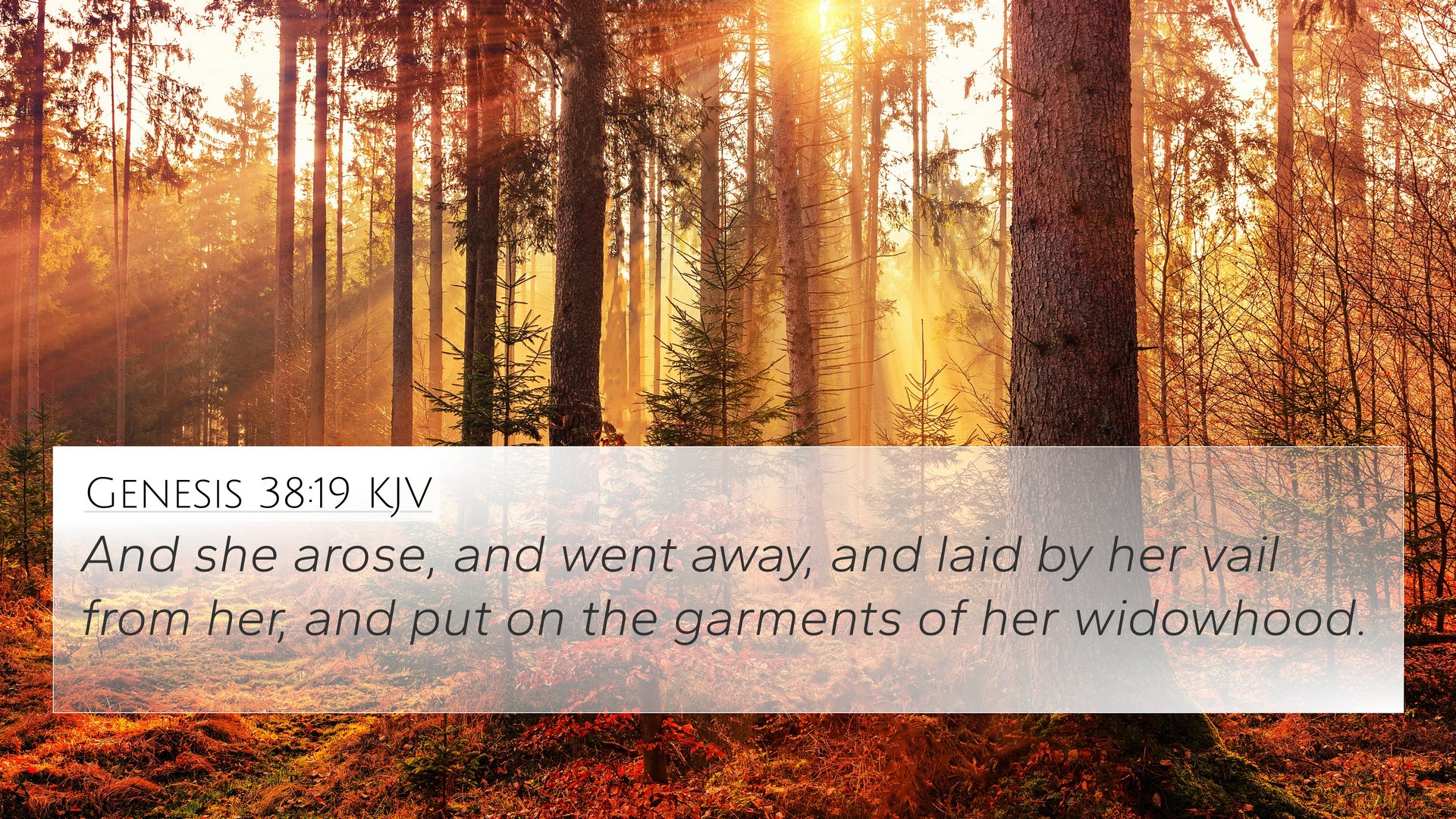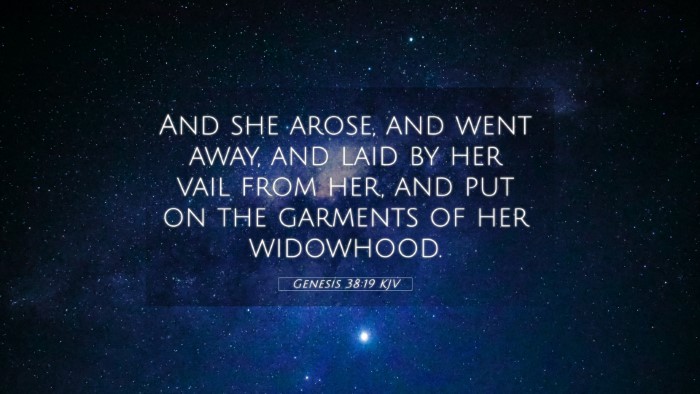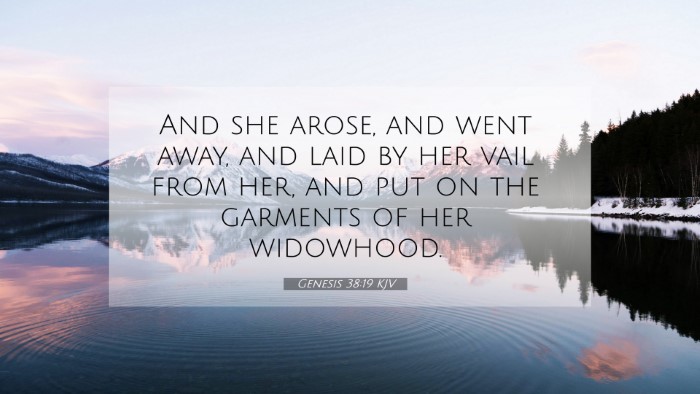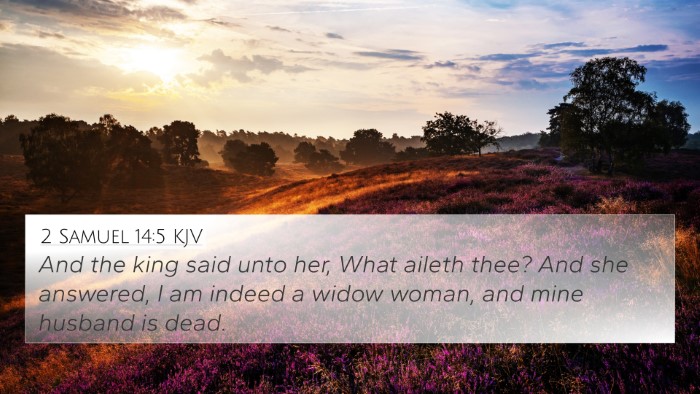Understanding Genesis 38:19
Genesis 38:19 states: "She also took off her veil, and put on the garments of her widowhood." This verse is part of the complex narrative involving Judah and Tamar. Below is a summary interpretation drawing from various public domain commentaries.
Context of Genesis 38
Genesis 38 recounts an important yet often overlooked story of Judah, one of the sons of Jacob. It highlights themes of morality, justice, and the unfolding of God's plan through unexpected circumstances. Tamar's actions must be understood within the cultural context of Levirate marriage, which was designed to protect widows and maintain family lineage.
Verse Meaning and Insights
-
Matthew Henry's Commentary:
Henry outlines how this passage illustrates the challenges Tamar faced as a widow, reflecting on her desperate attempt to secure her place in Judah's family lineage. By removing her veil, she was embodying the role of a harlot, thus emphasizing her cunning and determination to fulfill her rightful place in a lineage that God had promised should continue.
-
Albert Barnes' Notes:
Barnes notes that the act of taking off her widow's garments signifies an intentional shift in identity. Tamar’s decision to disguise herself demonstrates her proactive nature in pursuing justice and fairness, particularly in the face of Judah's neglect of his obligations to her. This act highlights the broader biblical themes of righteousness and the fulfillment of God's promises despite human failings.
-
Adam Clarke's Commentary:
Clarke discusses the societal implications of Tamar's actions. He underscores the necessity of her boldness in a patriarchal society where women were often powerless. Tamar's disguise is a symbol of her shrewdness and determination. Clarke often points to the moral complexities within such narratives, indicating how God's purposes operate through flawed human actions.
Thematic Connections between Bible Verses
This verse and its surrounding narrative connect to several significant themes in the Bible:
- Justice for the Marginalized: Tamar’s plight reflects a recurring biblical theme where God defends the rights of the oppressed. This theme can be found in Exodus 22:22-24 which advocates for the widow and the orphan.
- God’s Sovereignty in Human Affairs: The narrative illustrates how God can work through human actions, as seen in Romans 8:28 which assures believers that God works all things for good.
- Levirate Marriage Laws: The cultural aspects of Genesis 38 can be compared to the stipulations given in Deuteronomy 25:5-10, which establishes the duty of a brother to marry his deceased brother’s widow.
- God’s Promise to Judah: The genealogy of Jesus in Matthew 1:3-6 traces back to Judah, demonstrating God’s faithfulness despite human complexities such as those illustrated in Judah and Tamar’s story.
- Biblical Disguise and Identity: The theme of disguise is echoed in other Biblical narratives, such as in Genesis 27:15 where Rebekah dresses Jacob in Esau's clothes.
- The Role of Women in Redemption: Tamar’s actions play a significant role in the redemptive history leading to Christ, connecting to Hebrews 11:31, where Rahab is celebrated for her faith.
- Covenantal Faithfulness: The divine promise of lineage connects to Genesis 49:10, indicating that Judah’s lineage would bring forth the expected messianic king.
Cross-References for Genesis 38:19
To aid in a deeper understanding and cross-referencing of Genesis 38:19, consider the following verses:
- Exodus 22:22-24 - God’s protection of widows.
- Deuteronomy 25:5-10 - Levirate marriage law.
- Romans 8:28 - God's assurance of working all for good.
- Matthew 1:3-6 - The genealogy of Jesus highlighting Tamar.
- Hebrews 11:31 - Faith of Rahab amidst challenging circumstances.
- Genesis 49:10 - Prophecy concerning Judah’s descendants.
- Genesis 27:15 - The theme of disguise and identity.
- Luke 1:69 - The house of his servant David, connecting to Judah’s fulfillment in Christ.
- 1 Peter 2:9 - A chosen generation called to declare God’s praises, linking to God’s redemptive plan through Judah’s line.
- Revelation 5:5 - Reference to the Lion of the tribe of Judah, emphasizing the fulfillment of God’s purposes through this lineage.
Conclusion
Genesis 38:19 is not just a historical account, but a profound narrative woven into the fabric of God's redemptive history. The analysis of this verse encourages believers to see the intricate connections across Scriptures, where individual stories contribute to the overarching narrative of God's covenant with humanity.
By engaging in comparative Bible verse analysis and employing tools for Bible cross-referencing, one can uncover deeper truths and lessons that lie in the interplay between various biblical texts.





